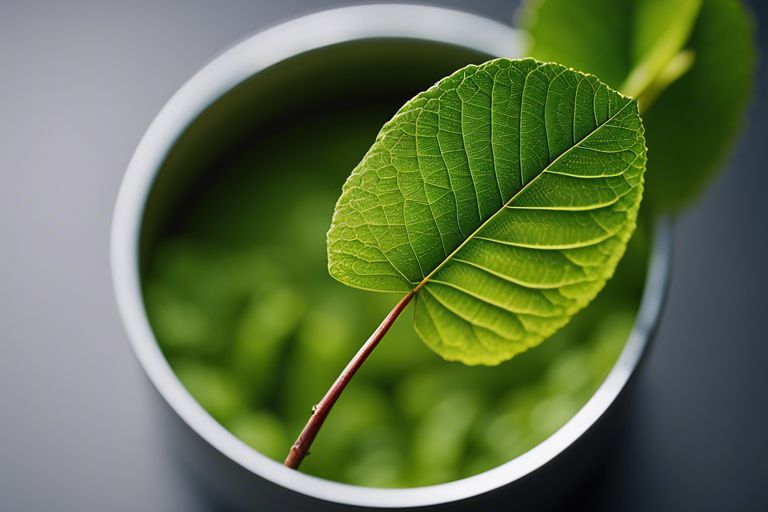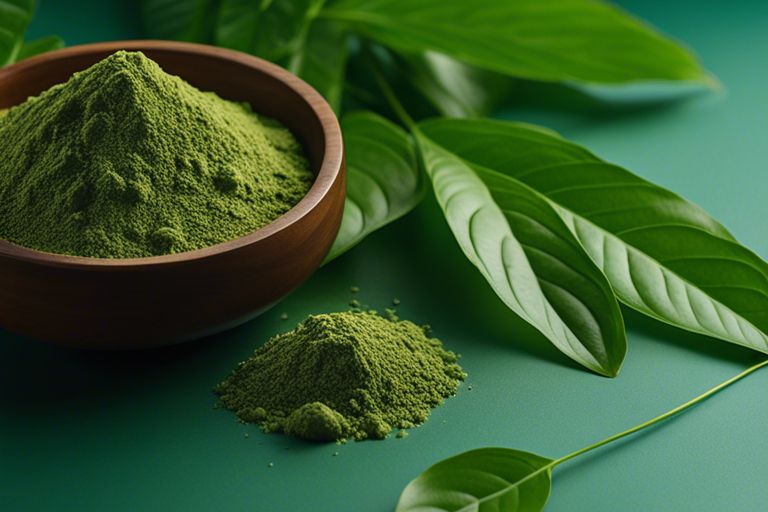Deprecated: mb_convert_encoding(): Handling HTML entities via mbstring is deprecated; use htmlspecialchars, htmlentities, or mb_encode_numericentity/mb_decode_numericentity instead in /home/users/kratomfiles/www/kratomfiles.com/wp-content/plugins/quick-adsense-reloaded/includes/template-functions.php on line 3552
Kratom, scientifically known as Mitragyna speciosa, is a tropical evergreen tree native to Southeast Asia. It belongs to the coffee family and has been used for centuries in traditional medicine to alleviate pain, boost energy, and improve mood. The leaves of the kratom tree contain active compounds called alkaloids, with the most prominent ones being mitragynine and 7-hydroxymitragynine. These alkaloids have opioid-like effects and can interact with the brain’s opioid receptors, leading to pain relief and a sense of euphoria. Kratom is commonly consumed by chewing the leaves, brewing them into a tea, or grinding them into a powder that can be ingested or added to foods.
Kratom has gained popularity in Western countries in recent years, with many people using it as an alternative to prescription pain medications or as a recreational substance. It is available in various forms, including capsules, tablets, and extracts, and can be purchased online or in specialty stores. While some individuals praise kratom for its potential therapeutic benefits, others have raised concerns about its safety and potential for abuse. The legal status of kratom varies by country and region, with some places banning its use and others allowing it for medicinal or recreational purposes.
Key Takeaways
- Kratom is a tropical tree native to Southeast Asia, known for its stimulant and opioid-like effects when consumed.
- Research suggests a potential link between kratom use and hyperpigmentation, a condition characterized by darkening of the skin.
- Hyperpigmentation is a common skin condition that occurs when the body produces excess melanin, leading to dark patches or spots on the skin.
- Kratom may affect the skin by altering hormone levels, leading to changes in melanin production and potentially causing hyperpigmentation.
- Potential risks and side effects of kratom use include liver damage, addiction, and withdrawal symptoms, in addition to the potential for skin-related issues such as hyperpigmentation.
The Link Between Kratom and Hyperpigmentation
Hyperpigmentation is a common skin condition characterized by the darkening of certain areas of the skin. It occurs when an excess of melanin, the pigment that gives skin its color, is produced in specific areas, leading to patches or spots that are darker than the surrounding skin. While hyperpigmentation can be caused by various factors such as sun exposure, hormonal changes, and skin injuries, recent reports have suggested a potential link between kratom use and the development of hyperpigmentation.
Several case studies have documented instances of individuals developing dark patches on their skin after using kratom regularly. These reports have raised concerns about the possible role of kratom in triggering or exacerbating hyperpigmentation. While the exact mechanisms underlying this association are not fully understood, it is believed that certain compounds in kratom may interfere with the normal functioning of melanocytes, the cells responsible for producing melanin. Additionally, some researchers have proposed that prolonged exposure to kratom may lead to liver dysfunction, which can in turn affect the metabolism of melanin and contribute to the development of hyperpigmentation.
Understanding Hyperpigmentation
Hyperpigmentation can manifest in different forms, including melasma, post-inflammatory hyperpigmentation, and age spots. Melasma is characterized by brown or grayish patches that typically appear on the face, particularly on the cheeks, forehead, and upper lip. It is often associated with hormonal changes, such as pregnancy or the use of oral contraceptives, and is more common in individuals with darker skin tones. Post-inflammatory hyperpigmentation, on the other hand, occurs as a result of skin trauma or inflammation, such as acne, eczema, or psoriasis. This type of hyperpigmentation can affect any part of the body and usually resolves over time.
Age spots, also known as liver spots or solar lentigines, are flat, brown, or black spots that develop on sun-exposed areas of the skin, such as the face, hands, and arms. They are more prevalent in older individuals and are attributed to cumulative sun exposure over the years. Regardless of the specific type, hyperpigmentation can have a significant impact on an individual’s self-esteem and quality of life. It can be challenging to treat and may require a combination of topical agents, laser therapy, and other interventions to achieve satisfactory results.
How Kratom May Affect the Skin
| Effect | Description |
|---|---|
| Dryness | Kratom may cause dryness and dehydration in the skin. |
| Itchiness | Some users have reported experiencing itchiness after using kratom. |
| Redness | Redness of the skin may occur as a result of kratom use. |
| Acne | There are anecdotal reports of kratom causing acne breakouts. |
The potential impact of kratom on the skin is not well-documented in scientific literature, but there are several ways in which kratom may influence skin health. First, kratom contains alkaloids that can interact with opioid receptors in the body, which may affect hormonal balance and immune function. Disruptions in hormonal levels and immune responses can contribute to skin issues such as acne, eczema, and psoriasis. Additionally, some individuals who use kratom may experience dehydration due to its diuretic effects, which can lead to dry and flaky skin.
Furthermore, there is evidence to suggest that prolonged use of kratom may lead to liver damage or dysfunction. The liver plays a crucial role in detoxifying the body and metabolizing various substances, including melanin. Liver impairment can disrupt the normal metabolism of melanin and contribute to the development of hyperpigmentation. Moreover, some individuals may be allergic to certain compounds in kratom, leading to allergic reactions that manifest as rashes or hives on the skin.
Potential Risks and Side Effects of Kratom Use
While kratom has been touted for its potential therapeutic benefits, it is not without risks and side effects. The most common side effects of kratom use include nausea, vomiting, constipation, dry mouth, and loss of appetite. In some cases, individuals may experience dizziness, drowsiness, or confusion after consuming kratom. Long-term use of kratom has been associated with dependence and withdrawal symptoms when discontinuing its use.
In addition to these common side effects, there have been reports of more serious adverse effects linked to kratom use. These include seizures, respiratory depression, liver damage, and even death in extreme cases. The U.S. Food and Drug Administration (FDA) has issued warnings about the potential dangers of using kratom, citing concerns about its addictive properties and potential for abuse. Furthermore, there is limited research on the long-term effects of kratom use on overall health and well-being.
Can Kratom Interactions Cause Hyperpigmentation on the Skin?
Kratom interaction information is important for those who use this herb. Some studies suggest that kratom interactions can lead to hyperpigmentation on the skin. It is essential to understand the potential side effects and interactions of kratom to prevent any adverse effects. Always consult a healthcare professional before using kratom.
Managing Hyperpigmentation Caused by Kratom

If you suspect that your hyperpigmentation may be related to kratom use, it is essential to consult a healthcare professional for an accurate diagnosis and appropriate management. Treatment for hyperpigmentation typically involves a combination of topical agents, such as hydroquinone or retinoids, to lighten dark spots and even out skin tone. In some cases, chemical peels or laser therapy may be recommended to target stubborn areas of hyperpigmentation.
In addition to addressing the skin concerns directly, it is crucial to address the underlying cause of hyperpigmentation by discontinuing kratom use under medical supervision. This may involve gradually tapering off kratom to minimize withdrawal symptoms and seeking support from healthcare providers or addiction specialists if needed. It is also important to adopt a comprehensive approach to skin care by using sunscreen daily to protect against further sun damage and incorporating gentle skincare products that promote skin healing and regeneration.
Conclusion and Recommendations
In conclusion, while kratom has gained popularity for its potential therapeutic effects, there are emerging concerns about its association with hyperpigmentation and other adverse effects on skin health. It is essential for individuals using kratom to be aware of the potential risks and side effects associated with its use and to seek medical advice if they experience any concerning symptoms. Healthcare professionals should remain vigilant for signs of hyperpigmentation in individuals using kratom and consider this possibility when evaluating patients with unexplained skin changes.
Given the limited research on the effects of kratom on skin health, further studies are needed to elucidate the mechanisms underlying its potential impact on hyperpigmentation and other dermatological conditions. In the meantime, individuals considering using kratom should weigh the potential benefits against the known risks and exercise caution when using this substance. It is crucial to prioritize overall health and well-being by seeking guidance from healthcare professionals and adopting safe and evidence-based approaches to managing health conditions.
If you’re interested in learning more about the different types of kratom and their effects, you should check out this article on Green Vietnam Kratom. It provides a detailed overview of the strain and its potential benefits. Additionally, it’s important to be aware of the potential side effects of kratom, such as hyperpigmentation, which is discussed in this article. Understanding the different strains and their potential effects can help individuals make informed decisions about their kratom use.










